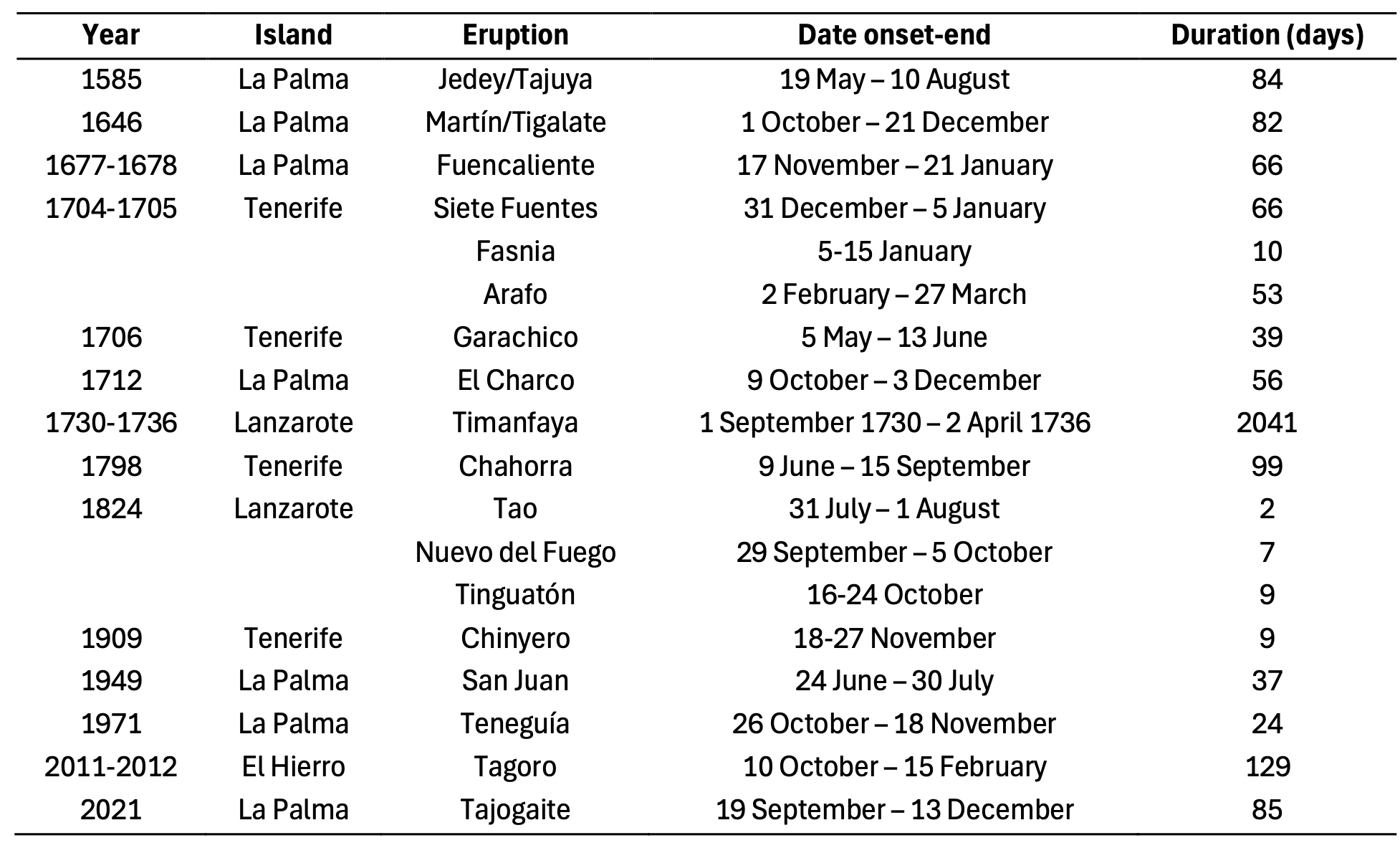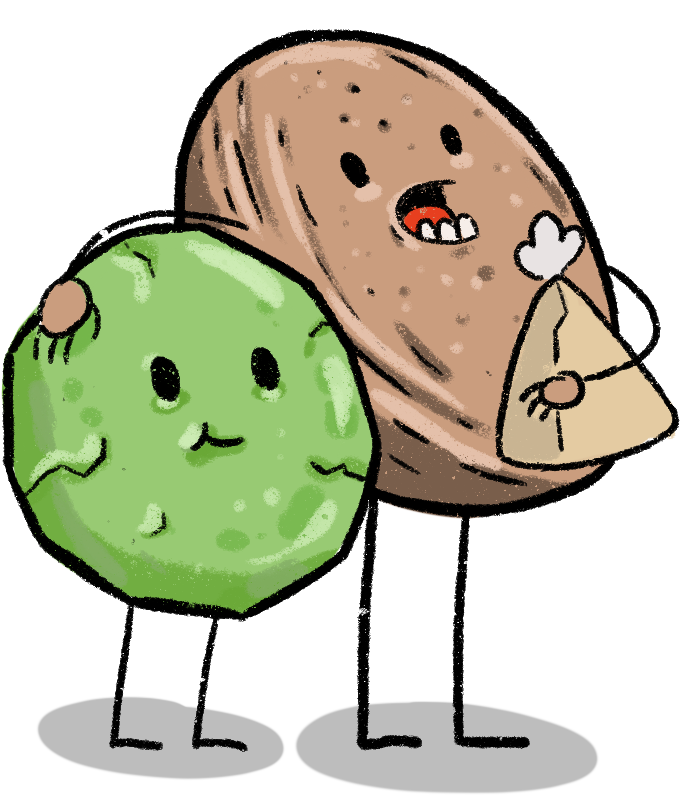Historical eruptions in the Canary Islands
Before we begin discussing the historical eruptions in the Canary Islands, let us briefly review what this concept means. A historical eruption is one that has been documented in writing. In the Canary Islands, the historical period began 500 years ago with the conquest of the archipelago. From then on, written records were kept of all the events that occurred in this region. Therefore, any eruption that has occurred in the Canary Islands over the past 500 years is considered historical.
In this time period, the Canary Islands have witnessed 14 historical volcanic eruptions: 7 in La Palma, 4 in Tenerife, 2 in Lanzarote, and 1 in El Hierro. Join us to discover what these eruptions were like!
When we talk about volcanic eruptions, one of the first questions that arises is: how long did they last? Well, the historical eruptions in the Canary Islands lasted from 10 days to just under 5 months. However, the Timanfaya eruption in Lanzarote far exceeds all the others because… it lasted 6 years! That is right, from 1730 to 1736.
Generally, these eruptions began with the opening of multiple vents along an eruptive fissure, where explosive activity (strombolian) dominated and was responsible for shaping the volcanic cones that are so characteristic of the Canary landscape (Figure 1a). After this initial phase, effusive activity followed with the emission of lava flows that, in some cases, formed extensive lava fields depending on the volume of magma emitted and the characteristics of the terrain (Figure 1b).

Figure 1. a. General view of Timanfaya National Park in Lanzarote; https://unsplash.com/. b. Lava flows emitted during the 2021 eruption in La Palma; https://unsplash.com/.
But as could not be otherwise, there are always exceptions… The eruptions of Tenerife in 1704-1705, Lanzarote in 1824, and La Palma in 1949 had a much more complex evolution. In each of them, multiple vents opened, separated by several kilometres. Therefore, we must keep in mind that more than one volcano can form during the same eruption.
Now that we know that not all eruptions are the same, let us look at two other cases that stand out for their duration and impact, as well as for their place of emission.
In the historical volcanism of the Canary Islands, the Timanfaya eruption in Lanzarote (1730-1736) is highly unusual in terms of duration and impact on society. The lava covered about 146 km², which is equivalent to around 20,000 football fields, destroying 26 villages and forcing a significant portion of the inhabitants of Lanzarote to abandon their land.

Figure 2. Effects on the surface of the Atlantic Ocean caused by the submarine eruption of the Tagoro Volcano, about 2 km south of La Restinga, on the island of El Hierro. Photograph taken from a helicopter flight conducted by the Instituto Geográfico Nacional (IGN) and the Guardia Civil on 4 November 2011.
As a final point in this blog about the historical eruptions in the Canary Islands, it is important to highlight that the time between the end of one eruption and the onset of another is not always the same. An example of this are the three eruptions that occurred in less than 10 years, between 1704 and 1712. On the opposite end, we have the case of the eruption that took place after 85 years of ‘calm’, between 1824 and 1909. Does this mean that the next eruption will occur, at most, in 85 years? Well, it is not that simple. Despite advances in volcanology, scientists cannot predict with certainty when the next eruption in the Canary Islands will take place. After all, volcanic eruptions are like people, all of them unique.
In the following table, you will find a summary of some of the most relevant characteristics for each historical eruption in the Canary Islands.
Note: – Only those historical eruptions whose events have been confirmed with dates and locations have been considered –

References
Carracedo, J.C., Troll, V.R., Day, J.M.D., Geiger, H., Aulinas, M., Soler, V., Deegan, F., Pérez-Torrado, F.J., Gisbert, G., Gazel, E., Rodriguez-Gonzalez, A., Albert, H., 2022. The 2021 eruption of the Cumbre Vieja volcanic ridge on La Palma, Canary Islands. Geol. Today 38, 94–107. https://doi.org/10.1111/gto.12388
Longpré, M.-A., Felpeto, A., 2021. Historical volcanism in the Canary Islands; part 1: A review of precursory and eruptive activity, eruption parameter estimates, and implications for hazard assessment. J. Volcanol. Geotherm. Res. 419, 107363. https://doi.org/10.1016/j.jvolgeores.2021.107363
If you want to cite this entre from the volkiblog:
Prieto-Torrell, C., Geyer, A., & Schamuells, N. (2025). HISTORICAL ERUPTIONS IN THE CANARY ISLANDS. Zenodo. https://doi.org/10.5281/zenodo.14607831
Texts: Claudia Prieto-Torrell (GEO3BCN-CSIC), Adelina Geyer (GEO3BCN-CSIC)
Illustrations: Noah Schamuells (GEO3BCN-CSIC)
Terms of use: This document is published under a CC By-NC-ND (Creative Commons Attribution-NonComercial-NoDerivates) license. Downloading and sharing is allowed freely as long as proper credit is given. It may not be changed in any way or used commercially. For more information about the CC By-NC-ND click here.
